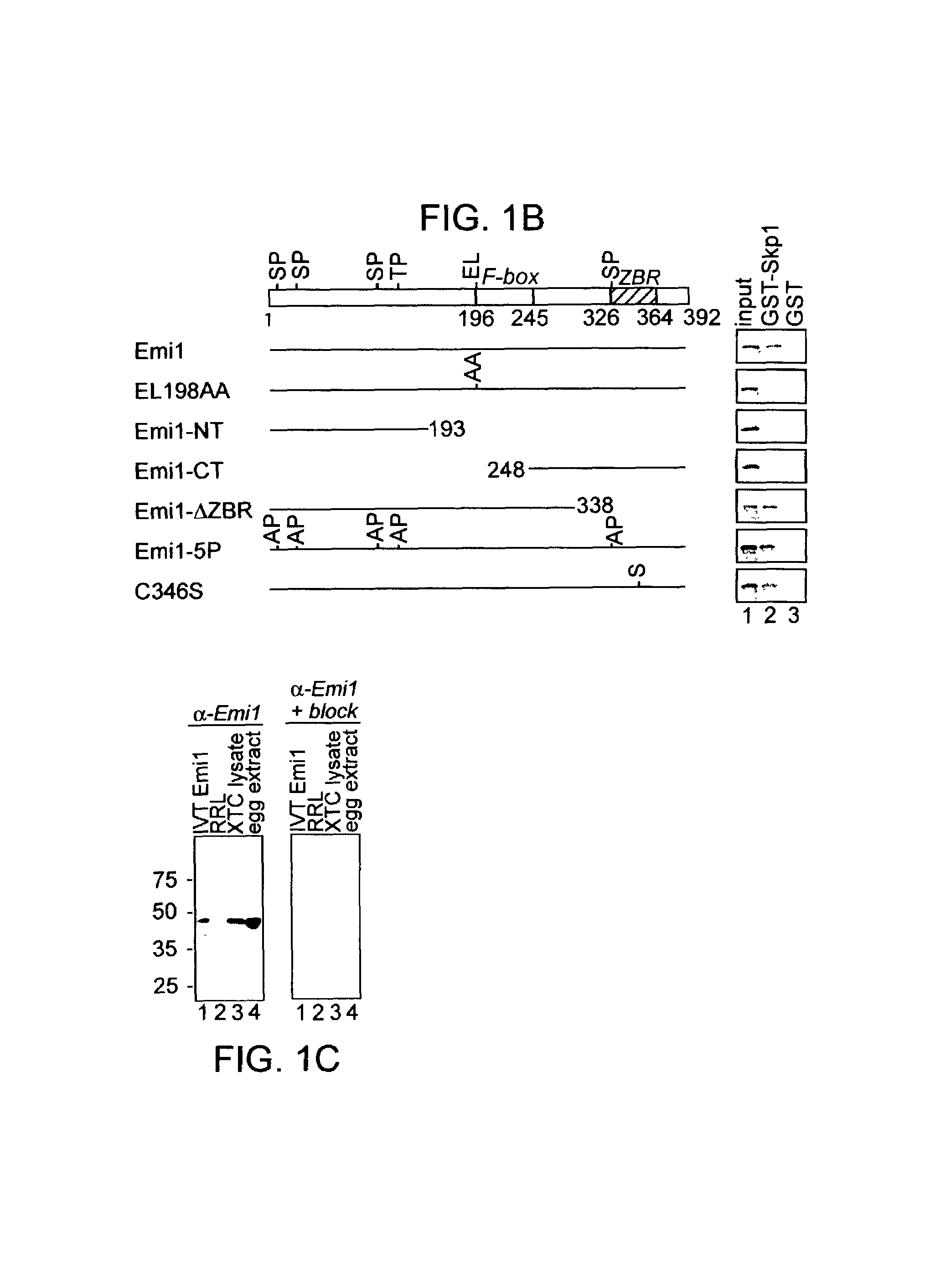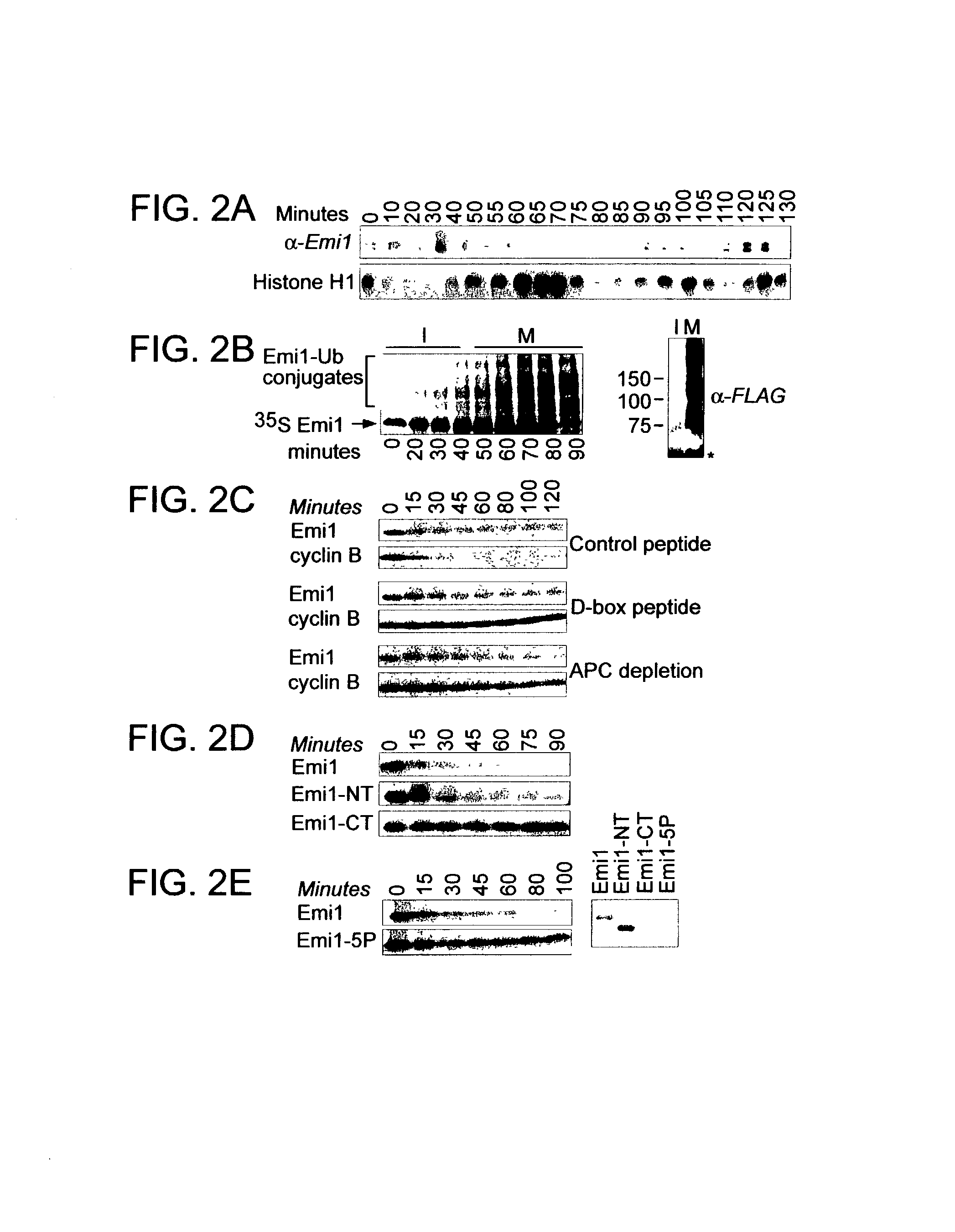Modulation of cell division by an early mitotic inhibitor protein
a technology of mitotic inhibitors and cell division, applied in the field of cell division by an early mitotic inhibitor protein, can solve the problems of genomic instability and/or cell death, unregulated cell cycle activity, etc., and achieve the effects of preventing the activation of the apc, modulating oocyte activation, and high cell turnover ra
- Summary
- Abstract
- Description
- Claims
- Application Information
AI Technical Summary
Problems solved by technology
Method used
Image
Examples
example 1
[0089]Xenopus Emi1 is a cell cycle regulated protein related to Drosophila Regulator of cyclin A (Rca1). Emi1 was initially isolated in a yeast two-hybrid screen for Skp1 binding proteins. The full-length Xenopus Emi1 oocyte cDNA was cloned. The predicted Emi1 protein is 392 residues long with an F-box, a zinc-binding region (ZBR), and five possible Cdk phosphorylation sites (FIGS. 1A and 1B). There are two potential nuclear localization sequences. BLAST search revealed that Emi1 has homology to the Drosophila protein Rca1 (FIG. 1A). Emi1 and Rca1 are similar in size, placement of functional domains, and share 25% similarity (16% identity). Emi1 is 43% similar (35% identical) to human Fbx5, a recently identified F-box protein of unknown function Cenciarelli et al. (1999) Current Biology 9:1177–9. Mutation or deletion of the Emi1 F-box abrogates binding to Skp1 in vitro (FIG. 1B).
[0090]Xenopus Emi1 and its homologs contain 8 cysteines and a histidine in the C-terminus that are highly...
example 2
The E2F-Dependent Accumulation of hEmi1 Regulates S Phase Entry by Inhibiting APCcdh1
[0139]It is shown herein that human Emi1 (hEmi1) functions to promote cyclin A accumulation and S phase entry in somatic cells by inhibiting the APCCdh1 complex. At the G1-S transition, hEmi1 is transcriptionally induced by the E2F transcription factor much like cyclin A. hEmi1 overexpression accelerates S phase entry and can override a G1 block caused by overexpression of Cdh1 or the E2F-inhibitor pRb. Depleting cells of hEmi1 through RNA interference prevents accumulation of cyclin A and inhibits S phase entry. These data demonstrate that E2F can activate both transcription of cyclin A and the hEmi1-dependent stabilization of APCCdh1 targets like cyclin A to promote S phase entry.
Results
[0140]hEmi1 has activities similar to the APCCdc20 inhibitor xEmi1. An affinity-purified rabbit polyclonal antibody was generated that recognizes both recombinant and endogenous human Emi1. Human Emi1 has similar ...
example 3
Emi1 is Required for Cytostatic Factor Arrest in Vertebrate Eggs
[0179]Vertebrate eggs are arrested at metaphase of meiosis II (MII) with stable cyclin B and high cyclin B / Cdc2 kinase activity. The ability of the anaphase-promoting complex / cyclosome (APC), an E3 ubiquitin ligase, to trigger cyclin B destruction and metaphase exit is blocked in eggs by the activity of cytostatic factor (CSF). CSF was defined as an activity in mature oocytes that caused mitotic arrest when injected into dividing embryos. Fertilization causes a transient increase in cytoplasmic calcium leading to CSF inactivation, APC activation, cyclin B destruction, and mitotic exit. The APC activator Cdc20 is required for APC activation following fertilization. It is shown herein that the APCCdc20 inhibitor Emi1 is required and sufficient to inhibit the APC and prevent mitotic exit in CSF-arrested eggs. CSF extracts immunodepleted of Emi1 degrade cyclin B and prematurely exit mitosis in the absence of calcium. Additi...
PUM
| Property | Measurement | Unit |
|---|---|---|
| molecular weight | aaaaa | aaaaa |
| molecular weight | aaaaa | aaaaa |
| concentration | aaaaa | aaaaa |
Abstract
Description
Claims
Application Information
 Login to View More
Login to View More - R&D
- Intellectual Property
- Life Sciences
- Materials
- Tech Scout
- Unparalleled Data Quality
- Higher Quality Content
- 60% Fewer Hallucinations
Browse by: Latest US Patents, China's latest patents, Technical Efficacy Thesaurus, Application Domain, Technology Topic, Popular Technical Reports.
© 2025 PatSnap. All rights reserved.Legal|Privacy policy|Modern Slavery Act Transparency Statement|Sitemap|About US| Contact US: help@patsnap.com



